Assessing Resource Management in Higher Education Sustainability Projects: A Bootstrap Dea Case Study
Abstract
1. Introduction
2. Related Works
3. Methodology
3.1. Model Selection
3.2. Variables Selection
3.3. Data Gathering
3.4. Outlier Detection
3.5. Return to Scale
3.6. Model Orientation
3.7. Bootstrap
4. Results
4.1. Projects Profile
4.2. Bootstrap DEA Application
5. Discussion
6. Final Considerations
Author Contributions
Funding
Institutional Review Board Statement
Informed Consent Statement
Data Availability Statement
Conflicts of Interest
Appendix A
| DMU | TS | B | W | PP | NB |
|---|---|---|---|---|---|
| DMU 1 | 37 | $8330.00 | 2430 | 1 | 50 |
| DMU 2 | 19 | $0.00 | 1140 | 0 | 1000 |
| DMU 3 | 9 | $4080.00 | 1292 | 1 | 183 |
| DMU 4 | 13 | $850.00 | 875 | 2 | 62 |
| DMU 5 | 22 | $8500.00 | 3396 | 2 | 161 |
| DMU 6 | 9 | $680.00 | 1658 | 0 | 750 |
| DMU 7 | 8 | $510.00 | 1000 | 0 | 255 |
| DMU 8 | 4 | $1360.00 | 360 | 0 | 50 |
| DMU 9 | 29 | $73.10 | 3400 | 0 | 400 |
| DMU 10 | 16 | $170.00 | 480 | 0 | 260 |
| DMU 11 | 17 | $51.00 | 1522 | 0 | 50 |
| DMU 12 | 3 | $2856.00 | 735 | 1 | 500 |
| DMU 13 | 15 | $22,666.67 | 1820 | 1 | 100 |
| DMU 14 | 6 | $0.00 | 1155 | 2 | 5 |
| DMU 15 | 5 | $68.00 | 555 | 0 | 57 |
| DMU 16 | 92 | $15,164.00 | 1952 | 4 | 59 |
| DMU 17 | 2 | $51,000.00 | 126 | 2 | 100 |
| DMU 18 | 42 | $13,804.00 | 5762 | 0 | 510 |
| DMU 19 | 24 | $68,000.00 | 1680 | 8 | 70 |
| DMU 20 | 20 | $0.00 | 1530 | 0 | 20 |
| Outlier 1 | 12 | $1071.00 | 1360 | 0 | 30,000 |
| Outlier 2 | 5 | $0.00 | 1095 | 1 | 8500 |
| Outlier 3 | 3 | $61,443.38 | 27 | 0 | 1500 |
Appendix B
| DMU | TS | B | W | PP | NB |
|---|---|---|---|---|---|
| DMU 1 | 36 | $8330.00 | 2430 | 1 | 50 |
| DMU 2 | 19 | $0.00 | 1140 | 0 | 1000 |
| DMU 3 | 9 | $4080.00 | 1292 | 1 | 183 |
| DMU 4 | 13 | $850.00 | 875 | 2 | 62 |
| DMU 5 | 22 | $8500.00 | 3217 | 2 | 161 |
| DMU 6 | 9 | $680.00 | 1658 | 0 | 750 |
| DMU 7 | 8 | $510.00 | 986 | 0 | 255 |
| DMU 8 | 4 | $1360.00 | 360 | 0 | 50 |
| DMU 9 | 27 | $73.10 | 2662 | 0 | 400 |
| DMU 10 | 15 | $170.00 | 480 | 0 | 260 |
| DMU 11 | 17 | $51.00 | 1488 | 0 | 50 |
| DMU 12 | 3 | $2856.00 | 735 | 1 | 500 |
| DMU 13 | 15 | $22,666.67 | 1815 | 1 | 100 |
| DMU 14 | 6 | $0.00 | 1155 | 2 | 5 |
| DMU 15 | 5 | $68.00 | 555 | 0 | 57 |
| DMU 16 | 42 | $15,164.00 | 1952 | 4 | 63 |
| DMU 17 | 2 | $51,000.00 | 126 | 2 | 100 |
| DMU 18 | 42 | $13,804.00 | 5079 | 0 | 510 |
| DMU 19 | 24 | $68,000.00 | 1680 | 8 | 70 |
| DMU 20 | 19 | $0.00 | 1496 | 0 | 20 |
References
- Ebi, K.L.; Vanos, J.; Baldwin, J.W.; Bell, J.E.; Hondula, D.M.; Errett, N.A.; Hayes, K.; Reid, C.E.; Saha, S.; Spector, J.; et al. Extreme weather and climate change: Population health and health system implications. Annu. Rev. Public Health 2021, 42, 293–315. [Google Scholar] [CrossRef]
- Brundtland, G.H.; Khalid, M. Our Common Future; Oxford University Press: Oxford, UK, 1987. [Google Scholar]
- Zaman, K. Environmental cost of deforestation in Brazil’s Amazon Rainforest: Controlling biocapacity deficit and renewable wastes for conserving forest resources. For. Ecol. Manag. 2022, 504, 119854. [Google Scholar] [CrossRef]
- Grupo de Trabalho da Sociedade Civil para a Agenda 2030. VIII Relatório Luz da Sociedade Civil da Agenda 2030; GT Agenda 2030. Gestos-Soropositividade, Comunicação e Gênero: Recife, Brazil, 2024. [Google Scholar]
- Geissdoerfer, M.; Savaget, P.; Bocken, N.M.P.; Hultink, E.J. The Circular Economy—A new sustainability paradigm? J. Clean. Prod. 2017, 143, 757–768. [Google Scholar] [CrossRef]
- Porter, M.E.; Kramer, M.R. Creating shared value. Harv. Bus. Rev. 2011, 89, 62–77. [Google Scholar]
- Sachs, J.D. The Age of Sustainable Development; Columbia University Press: New York, NY, USA, 2015. [Google Scholar]
- Curi Filho, W.R.; Wood, T. Avaliação do Impacto das Universidades em Suas Comunidades. Cadernos EBAPE. BR 2021, 19, 496–509. [Google Scholar] [CrossRef]
- QS. QS World University Rankings: Sustainability 2024. 2024. Available online: https://www.topuniversities.com/sustainability-rankings?countries=br (accessed on 23 March 2025).
- Basheer, N.; Ahmed, V.; Bahroun, Z.; Anane, C. Exploring sustainability assessment practices in higher education: A comprehensive review through content and bibliometric analyses. Sustainability 2024, 16, 5799. [Google Scholar] [CrossRef]
- Charnes, A.; Cooper, W.W.; Rhodes, E. Measuring the efficiency of decision-making units. Eur. J. Oper. Res. 1978, 2, 429–444. [Google Scholar] [CrossRef]
- Tone, K. A slacks-based measure of efficiency in data envelopment analysis. Eur. J. Oper. Res. 2001, 130, 498–509. [Google Scholar] [CrossRef]
- Fried, H.O.; Lovell, C.A.K.; Schmidt, S.S.; Yaisawarng, S. Accounting for environmental effects and statistical noise in data envelopment analysis. J. Product. Anal. 2002, 17, 91–114. [Google Scholar] [CrossRef]
- Caves, D.W.; Christensen, L.R.; Diewert, W.E. The economic theory of index numbers and the measurement of input, output, and productivity. Econometrica 1982, 50, 1393–1414. [Google Scholar] [CrossRef]
- Färe, R.; Grosskopf, S.; Norris, M.; Zhang, Z. Productivity growth, technical progress, and efficiency change in industrialized countries. Am. Econ. Rev. 1994, 84, 66–83. [Google Scholar]
- Zhang, R.; Wei, Q.; Li, A.; Chen, S. A new intermediate network data envelopment analysis model for evaluating China’s sustainability. J. Clean. Prod. 2022, 356, 131845. [Google Scholar] [CrossRef]
- Sueyoshi, T.; Goto, M. World trend in energy: An extension to DEA applied to energy and environment. J. Econ. Struct. 2017, 6, 1–23. [Google Scholar] [CrossRef]
- Panwar, N.; Olfati, M.; Pant, P.; Snasel, V. Review of the evolution of data envelopment analysis: A bibliometric approach. Sustainability 2022, 14, 2219. [Google Scholar]
- Tsaples, G.; Papathanasiou, J. Data envelopment analysis and the concept of sustainability: A review and analysis of the literature. Renew. Sustain. Energy Rev. 2021, 138, 110664. [Google Scholar] [CrossRef]
- Shang, Y.; Song, M.; Zhao, X. The development of China’s Circular Economy: From the perspective of environmental regulation. Waste Manag. 2022, 149, 186–198. [Google Scholar] [CrossRef]
- Xia, B.; Dong, S.; Li, Z.; Zhao, M.; Sun, D.; Zhang, W.; Li, Y. Eco-efficiency and its drivers in tourism sectors with respect to carbon emissions from the supply chain: An integrated EEIO and DEA approach. Int. J. Environ. Res. Public Health 2022, 19, 6951. [Google Scholar] [CrossRef]
- Zou, W.; Zhang, L.; Xu, J.; Xie, Y.; Chen, H. Spatial–temporal evolution characteristics and influencing factors of industrial pollution control efficiency in China. Sustainability 2022, 14, 5152. [Google Scholar] [CrossRef]
- Li, G.; Wang, P.; Pal, R. Measuring sustainable technology R&D innovation in China: A unified approach using DEA-SBM and projection analysis. Expert Syst. Appl. 2022, 209, 118393. [Google Scholar]
- Le, M.T.; Nhieu, N.L. An offshore wind–wave energy station location analysis by a novel behavioral dual-side spherical fuzzy approach: The case study of Vietnam. Appl. Sci. 2022, 12, 5201. [Google Scholar] [CrossRef]
- Qin, W.; Qi, X. Evaluation of green logistics efficiency in Northwest China. Sustainability 2022, 14, 6848. [Google Scholar] [CrossRef]
- Li, Y.; Yang, Y.; Luo, G.; Huang, J.; Wu, T. The economic recovery from traffic restriction policies during the COVID-19 through the perspective of regional differences and sustainable development: Based on human mobility data in China. Sustainability 2022, 14, 6453. [Google Scholar] [CrossRef]
- Gava, O.; Antón, A.; Carmassi, G.; Pardossi, A.; Incrocci, L.; Bartolini, F. Reusing drainage water and substrate to improve the environmental and economic performance of Mediterranean greenhouse cropping. J. Clean. Prod. 2023, 413, 137510. [Google Scholar] [CrossRef]
- Li, B.; Huo, Y.; Yin, S. Sustainable financing efficiency and environmental value in China’s energy conservation and environmental protection industry under the double carbon target. Sustainability 2022, 14, 9604. [Google Scholar] [CrossRef]
- Yang, G.; Yang, Y.; Gong, G.; Gui, Q. The spatial network structure of tourism efficiency and its influencing factors in China: A social network analysis. Sustainability 2022, 14, 9921. [Google Scholar] [CrossRef]
- Huang, X.; Lu, X.; Sun, Y.; Yao, J.; Zhu, W. A Comprehensive Performance Evaluation of Chinese Energy Supply Chain under “Double-Carbon” Goals Based on AHP and Three-Stage DEA. Sustainability 2022, 14, 10149. [Google Scholar] [CrossRef]
- Chang, M.; Liu, J.; Shi, H.; Guo, T. The effect of off-farm employment on agricultural production efficiency: Micro evidence in China. Sustainability 2022, 14, 3385. [Google Scholar] [CrossRef]
- Salazar, C.; Cárdenas-Retamal, R.; Jaime, M. Environmental efficiency in the salmon industry—An exploratory analysis around the 2007 ISA virus outbreak and subsequent regulations in Chile. Environ. Dev. Sustain. 2023, 25, 8107–8135. [Google Scholar] [CrossRef]
- Zhang, Q.; Razzaq, A.; Qin, J.; Feng, Z.; Ye, F.; Xiao, M. Does the expansion of farmers’ operation scale improve the efficiency of agricultural production in China? Implications for environmental sustainability. Front. Environ. Sci. 2022, 10, 918060. [Google Scholar] [CrossRef]
- Feng, J.; Wang, N.; Sun, G. Measurement of innovation-driven development performance of large-scale environmental protection enterprises investing in public–private partnership projects based on the hybrid method. Sustainability 2022, 14, 5096. [Google Scholar] [CrossRef]
- Han, S.; Park, S.; An, S.; Choi, W.; Lee, M. Research on Analyzing the Efficiency of R&D Projects for Climate Change Response Using DEA–Malmquist. Sustainability 2023, 15, 8433. [Google Scholar] [CrossRef]
- Ebnerasoul, M.; Ghannadpour, S.F.; Haeri, A. A collective efficacy-based approach for bi-objective sustainable project portfolio selection using interdependency network model between projects. Environ. Dev. Sustain. 2023, 25, 13981–14001. [Google Scholar] [CrossRef]
- Sun, Y.; Zhang, R.; Li, A. A new concept of education-innovation-economy-environment sustainability system: A new framework of strategy-based network data envelopment analysis. Environ. Dev. Sustain. 2024, 1–45. [Google Scholar] [CrossRef]
- Li, R.; Luo, Y.; Chen, B.; Huang, H.; Liu, P. Efficiency of scientific and technological resource allocation in Chengdu-Chongqing-Mianyang Urban agglomeration: Based on DEA–Malmquist index model. Environ. Dev. Sustain. 2024, 26, 10461–10483. [Google Scholar] [CrossRef]
- Liu, P.; Han, G.; Yang, H.; Li, X. A sustainable development study on innovation factor allocation efficiency and spatial correlation based on regions along the belt and road in China. Sustainability 2024, 16, 2990. [Google Scholar] [CrossRef]
- You, M.; Huang, Y.; Wu, N.; Yuan, X. Efficiency Evaluation and Resource Optimization of Forestry Carbon Sequestration Projects: A Case Study of State-Owned Forest Farms in Fujian Province. Sustainability 2025, 17, 375. [Google Scholar] [CrossRef]
- Callens, I.; Tyteca, D. Towards Indicators of Sustainable Development for Firms: A Productive Efficiency Perspective. Ecol. Econ. 1999, 28, 41–53. [Google Scholar] [CrossRef]
- Zhou, H.; Yang, Y.; Chen, Y.; Zhu, J. Data envelopment analysis application in sustainability: The origins, development and future directions. Eur. J. Oper. Res. 2018, 264, 1–16. [Google Scholar] [CrossRef]
- Letti, A.G.; Bittencourt, M.V.L.; Vila, L.E. Stochastic vs. deterministic frontier distance output function: Evidence from Brazilian higher education institutions. J. Product. Anal. 2022, 58, 55–74. [Google Scholar] [CrossRef]
- Andersen, P.; Petersen, N.C. A procedure for ranking efficient units in data envelopment analysis. Manag. Sci. 1993, 39, 1261–1264. [Google Scholar] [CrossRef]
- Lovell, C.A.K.; Rouse, R. Measuring the efficiency of decision-making units using data envelopment analysis. Oper. Res. 2003, 51, 493–503. [Google Scholar]
- Emrouznejad, A.; Cabanda, E. Super-efficiency in DEA: A review of the literature. Int. J. Appl. Manag. Sci. 2014, 6, 167–188. [Google Scholar]
- Simar, L.; Wilson, P.W.; Paul, L. A general methodology for bootstrapping in data envelopment analysis. J. Oper. Res. Soc. 2022, 53, 23–29. [Google Scholar]
- Peña, J.M. Data Envelopment Analysis: A Methodology for Assessing the Efficiency of Decision-Making Units; Springer Science and Business Media: Berlin/Heidelberg, Germany, 2008. [Google Scholar]
- Simar, L.; Wilson, P.W. Sensitivity analysis of efficiency scores: How to bootstrap in nonparametric frontier models. Manag. Sci. 1998, 44, 49–61. [Google Scholar] [CrossRef]
- Simar, L.; Wilson, P.W. Statistical inference in nonparametric frontier models: The state of the art. J. Product. Anal. 2000, 13, 49–78. [Google Scholar] [CrossRef]
- Simar, L.; Wilson, P.W. A general methodology for bootstrapping in non-parametric frontier models. J. Appl. Stat. 2000, 27, 779–802. [Google Scholar] [CrossRef]
- Simar, L.; Wilson, P.W. Two-stage DEA: Caveat emptor. J. Product. Anal. 2011, 36, 205–218. [Google Scholar] [CrossRef]
- Serrano, A.L.; Saiki, G.M.; Rosano-Penã, C.; Rodrigues, G.A.P.; Albuquerque, R.D.O.; Villalba, L.J.G. Bootstrap method of eco-efficiency in the Brazilian agricultural industry. Systems 2024, 12, 136. [Google Scholar] [CrossRef]
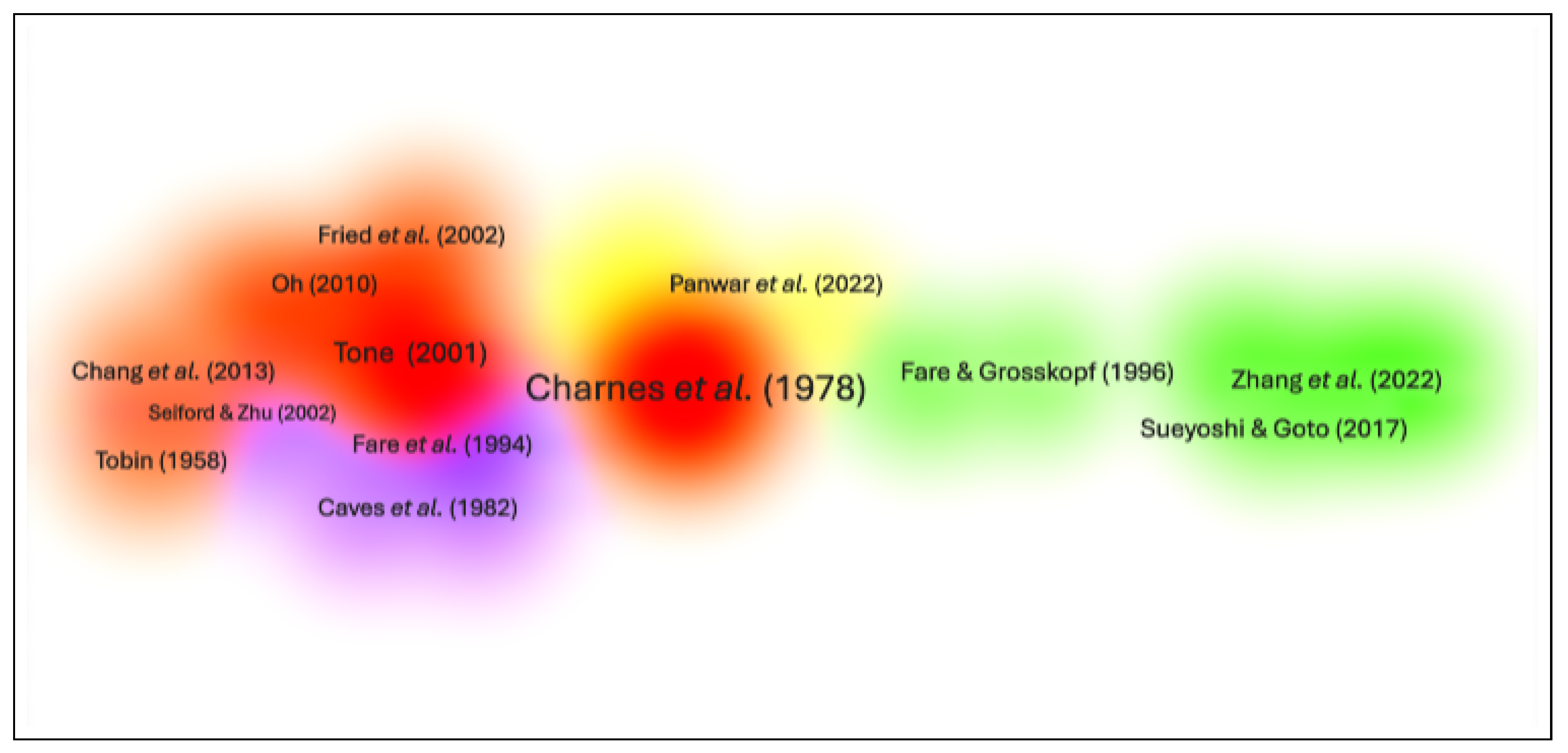
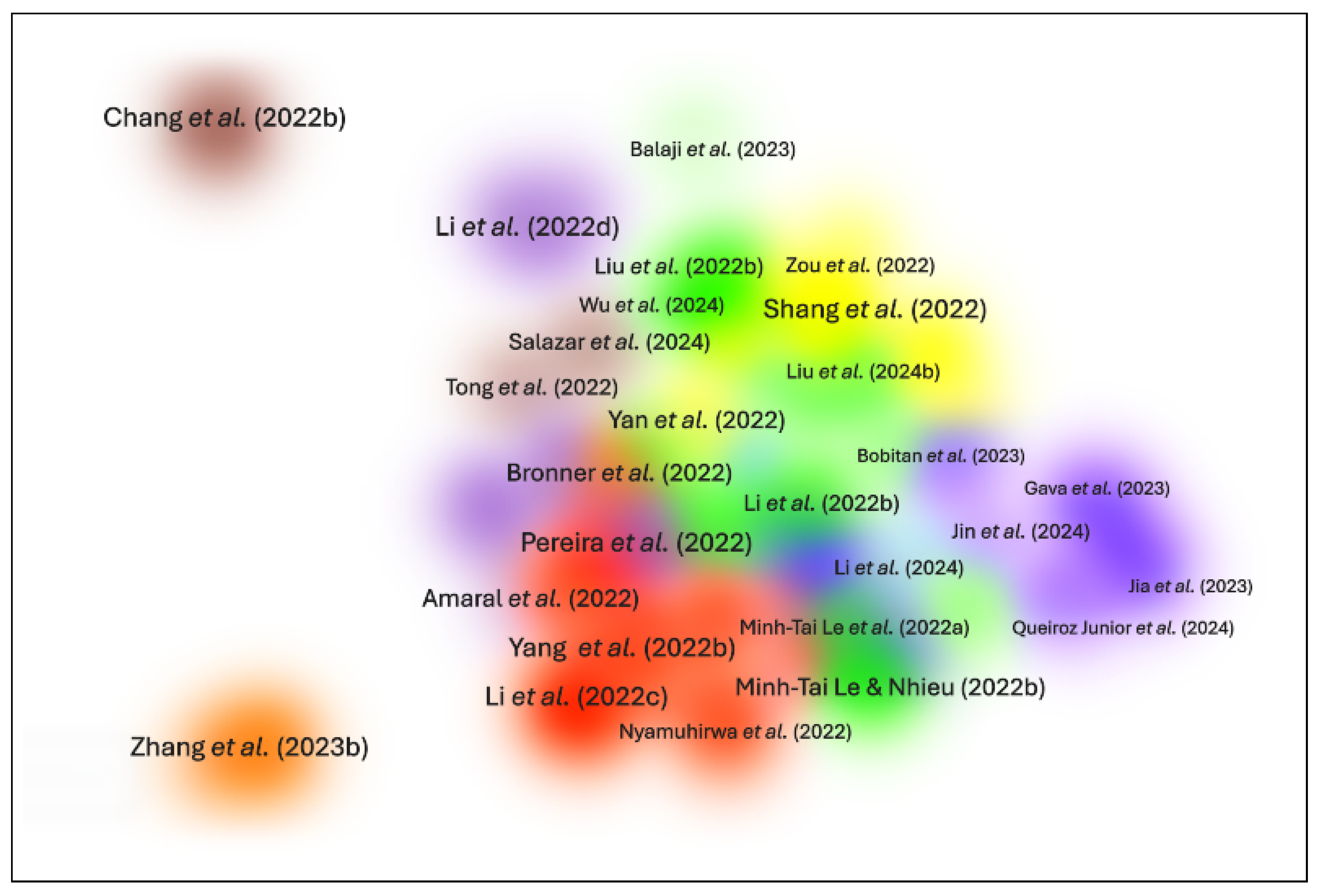
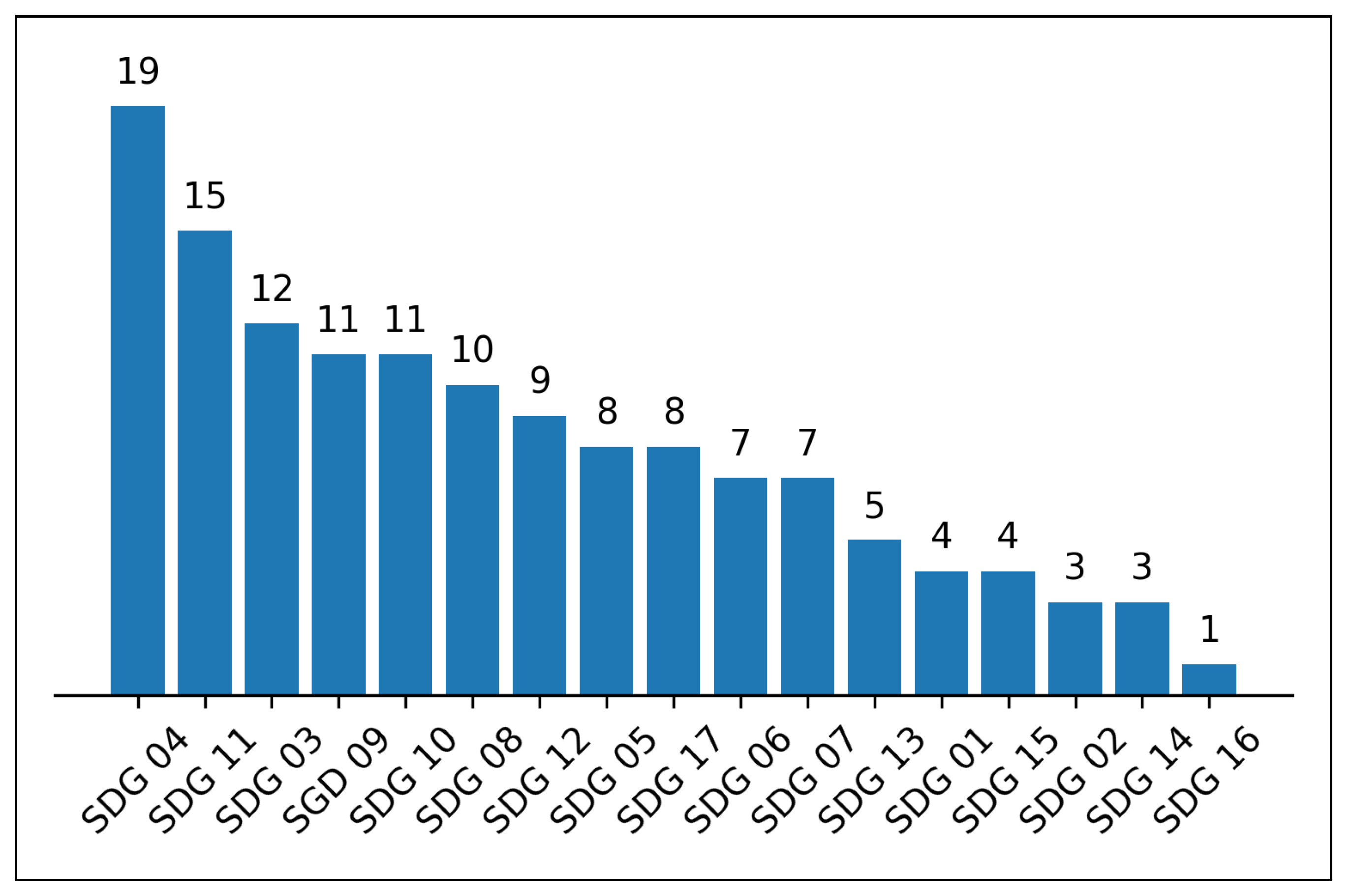
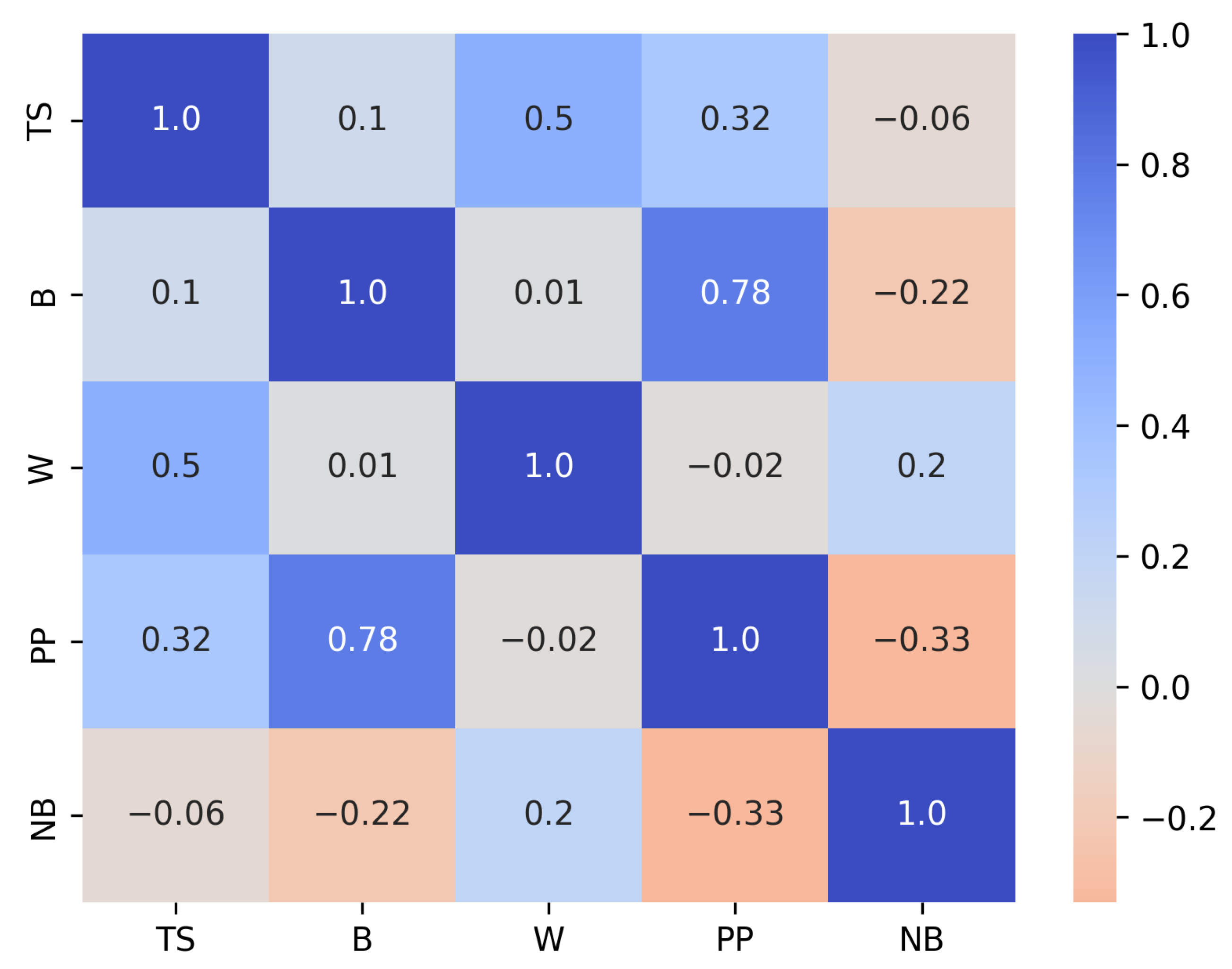
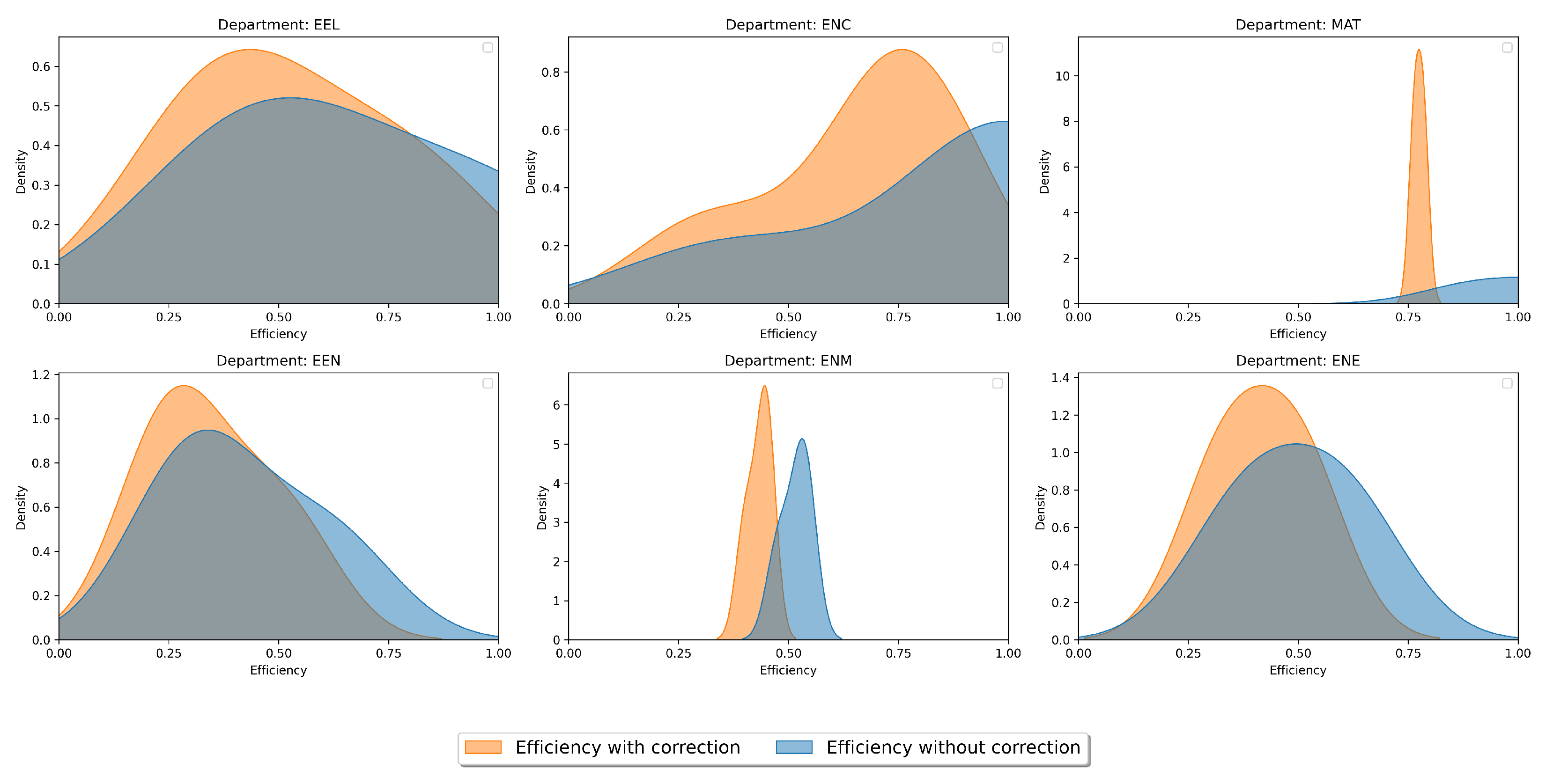
| Article | Overview |
|---|---|
| [23] | Use of a DEA-SBM-PA model to evaluate green technology R&D efficiency in China (2011–2017). The results highlight efficiency disparities and identify improvement potentials for inefficient provinces. |
| [34] | Application of DEA with stochastic frontier analysis to assess innovation-driven performance in 20 environmental protection enterprises (2018–2020). The findings suggest optimizing resource use and labor-capital transformation for better efficiency. |
| [35] | Analysis of 1500 climate change R&D projects in Korea (2014–2020) using DEA. The results highlight inefficiencies in both technical and scale perspectives and propose improvement strategies to enhance national R&D efficiency. |
| [36] | Proposal of a sustainable model for project portfolio selection using DEA and Bayesian network modeling. The authors show the model outperforms traditional methods in a real case with 21 projects. |
| [37] | Introduction of a new sustainability system combining network DEA, K-means clustering, and the Gini coefficient to evaluate university performance in promoting economic growth and environmental protection in China (2007–2019). The results show efficiency regress, with education-innovation gaining greater priority over economy-environment. |
| [38] | Use of DEA-Malmquist analysis to evaluate technological resource allocation efficiency in the Chengdu-Chongqing-Mianyang region (2010–2019). The findings show an upward trend in efficiency, driven by technological progress and strong policy support. |
| [39] | Application of a super-efficient SBM-DEA-Malmquist model to evaluate innovation factor allocation along the Belt and Road in China (2012–2021). The results show strong agglomeration, with policy recommendations for enhancing regional innovation development. |
| [40] | Use of DEA to assess the operational efficiency of 14 state-owned forestry carbon sink projects in Fujian, identifying management capability and climate conditions as key efficiency factors. The findings suggest investment barriers limit small-scale forest farms from engaging in such projects. |
| Type | Variable | Abbreviation | Unit of Measure |
|---|---|---|---|
| Input | Team Size | TS | People |
| Project Budget | B | USD | |
| Workload | W | Hours | |
| Output | Published Papers | PP | Papers |
| Number of Beneficiaries | NB | People |
| DMU | Department | with Correction | 95% Confidence Level | Without Correction | |
|---|---|---|---|---|---|
| Minimum | Maximum | ||||
| DMU 4 | EEL | 0.8131 | 0.7031 | 0.9723 | 1.0000 |
| DMU 7 | EEL | 0.4690 | 0.4064 | 0.5558 | 0.5669 |
| DMU 13 | EEL | 0.3076 | 0.2649 | 0.3672 | 0.3754 |
| DMU 6 | ENC | 0.8030 | 0.6689 | 0.9754 | 1.0000 |
| DMU 17 | ENC | 0.7457 | 0.6211 | 0.9861 | 1.0000 |
| DMU 2 | ENC | 0.7429 | 0.6266 | 0.9766 | 1.0000 |
| DMU 20 | ENC | 0.3184 | 0.2751 | 0.3616 | 0.3668 |
| DMU 14 | MAT | 0.7846 | 0.6709 | 0.9772 | 1.0000 |
| DMU 12 | MAT | 0.7637 | 0.6576 | 0.9803 | 1.0000 |
| DMU 3 | EEN | 0.5136 | 0.4468 | 0.6053 | 0.6211 |
| DMU 1 | EEN | 0.2962 | 0.2548 | 0.3424 | 0.3514 |
| DMU 18 | EEN | 0.2310 | 0.1933 | 0.2738 | 0.2794 |
| DMU 5 | ENM | 0.4466 | 0.3804 | 0.5287 | 0.5393 |
| DMU 8 | ENM | 0.4503 | 0.3919 | 0.5194 | 0.5297 |
| DMU 15 | ENM | 0.4020 | 0.3531 | 0.4687 | 0.4768 |
| DMU 9 | ENE | 0.5031 | 0.4266 | 0.5923 | 0.6065 |
| DMU 11 | ENE | 0.3315 | 0.2893 | 0.3771 | 0.3836 |
| DMU 19 | DSC | 0.7567 | 0.6339 | 0.9666 | 1.0000 |
| DMU 16 | EPR | 0.7190 | 0.6260 | 0.8339 | 0.8597 |
| DMU 10 | EAU | 0.5739 | 0.4902 | 0.6841 | 0.6974 |
| DMU | TS | B | W | PP | NB |
|---|---|---|---|---|---|
| DMU 1 | 2.5% | 0.0% | 0.0% | 0.0% | 0.0% |
| DMU 2 | 0.0% | 0.0% | 0.0% | 0.0% | 0.0% |
| DMU 3 | 0.0% | 0.0% | 0.0% | 0.0% | 0.0% |
| DMU 4 | 0.0% | 0.0% | 0.0% | 0.0% | 0.0% |
| DMU 5 | 0.0% | 0.0% | 5.3% | 0.0% | 0.0% |
| DMU 6 | 0.0% | 0.0% | 0.0% | 0.0% | 0.0% |
| DMU 7 | 0.0% | 0.0% | 1.4% | 0.0% | 0.0% |
| DMU 8 | 1.2% | 0.0% | 0.0% | 0.0% | 0.0% |
| DMU 9 | 8.1% | 0.0% | 21.7% | 0.0% | 0.0% |
| DMU 10 | 9.4% | 0.0% | 0.0% | 0.0% | 0.0% |
| DMU 11 | 2.7% | 0.0% | 2.2% | 0.0% | 0.0% |
| DMU 12 | 0.0% | 0.0% | 0.0% | 0.0% | 0.0% |
| DMU 13 | 0.0% | 0.0% | 0.3% | 0.0% | 0.0% |
| DMU 14 | 0.0% | 0.0% | 0.0% | 0.0% | 0.0% |
| DMU 15 | 0.1% | 0.0% | 0.0% | 0.0% | 0.0% |
| DMU 16 | 53.9% | 0.0% | 0.0% | 0.0% | 7.5% |
| DMU 17 | 0.0% | 0.0% | 0.0% | 0.0% | 0.0% |
| DMU 18 | 0.0% | 0.0% | 11.8% | 0.0% | 0.0% |
| DMU 19 | 0.0% | 0.0% | 0.0% | 0.0% | 0.0% |
| DMU 20 | 4.0% | 0.0% | 2.2% | 0.0% | 0.0% |
Disclaimer/Publisher’s Note: The statements, opinions and data contained in all publications are solely those of the individual author(s) and contributor(s) and not of MDPI and/or the editor(s). MDPI and/or the editor(s) disclaim responsibility for any injury to people or property resulting from any ideas, methods, instructions or products referred to in the content. |
© 2025 by the authors. Licensee MDPI, Basel, Switzerland. This article is an open access article distributed under the terms and conditions of the Creative Commons Attribution (CC BY) license (https://creativecommons.org/licenses/by/4.0/).
Share and Cite
Casonatto, R.; Souza, T.; Silva, G.; Oliveira, V.; Monteiro, S. Assessing Resource Management in Higher Education Sustainability Projects: A Bootstrap Dea Case Study. Sustainability 2025, 17, 8653. https://doi.org/10.3390/su17198653
Casonatto R, Souza T, Silva G, Oliveira V, Monteiro S. Assessing Resource Management in Higher Education Sustainability Projects: A Bootstrap Dea Case Study. Sustainability. 2025; 17(19):8653. https://doi.org/10.3390/su17198653
Chicago/Turabian StyleCasonatto, Ricardo, Tales Souza, Gustavo Silva, Victor Oliveira, and Simone Monteiro. 2025. "Assessing Resource Management in Higher Education Sustainability Projects: A Bootstrap Dea Case Study" Sustainability 17, no. 19: 8653. https://doi.org/10.3390/su17198653
APA StyleCasonatto, R., Souza, T., Silva, G., Oliveira, V., & Monteiro, S. (2025). Assessing Resource Management in Higher Education Sustainability Projects: A Bootstrap Dea Case Study. Sustainability, 17(19), 8653. https://doi.org/10.3390/su17198653







